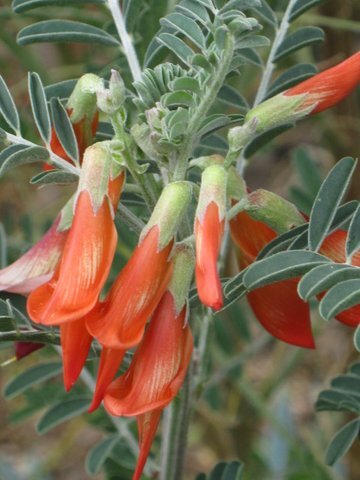Lessertia frutescens
(L.) Goldblatt & J.C.Manning Cancer BushHoary, soft-wooded shrub to c. 1 m high; stems ribbed. Leaves 6–9 cm long; leaflets 7–25, elliptic to oblong or narrowly obovate, 3–15 mm long, 2–6 mm wide, apices truncate or emarginate, upper surface grey-green, glabrous, lower surface pubescent; stipules to c. 2 mm long. Racemes 2–8-flowered; pedicle 5–6 mm long; bracts triangular, 1–2 mm long; bracteole c. 1 mm long; flowers 25–30 mm long; calyx 8–9 mm long, pubescent; petals scarlet or red; standard oblong, c. 20 mm long, c. 14 mm wide, recurved, shortly clawed; wings elliptic, 7–9 mm long; keel longer than standard. Pod ovoid-oblong, 3–5 cm long, 1–2 cm wide, inflated, chartaceous, hyaline; seeds to 15, cordate to reniform, 2.5–3 mm long, green. Flowers Aug.–Jan.
MuM, Gold. Also naturalised WA, SA, NSW. Native to South Africa. Recorded in near Wedderburn and Robinvale, but it is unclear if plants have persisted at either site.
The common name refers to its purported benefit in treating some cancers. The efficacy of this treatment is under investigation.
 Spinning
Spinning



